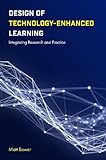Design of technology-enhanced learning : integrating research and practice / by Matt Bower.
Material type: TextPublication details: Bingley, UK : Emerald Publishing, 2017.Edition: First editionDescription: 1 online resourceContent type:
TextPublication details: Bingley, UK : Emerald Publishing, 2017.Edition: First editionDescription: 1 online resourceContent type: - text
- computer
- online resource
- 9781787141827
- 1787141829
- 9781787149113
- 1787149110
- Educational technology
- Education -- Effect of technological innovations on
- Web-based instruction
- Technologie éducative
- Éducation -- Effets des innovations sur
- Educational equipment & technology, computer-aided learning (Calif.)
- EDUCATION -- Administration -- General
- EDUCATION -- Organizations & Institutions
- Education -- Effect of technological innovations on
- Educational technology
- Web-based instruction
- 371.33 23
- LB1028.3 .B69 2017
| Item type | Home library | Collection | Call number | Materials specified | Status | Date due | Barcode | |
|---|---|---|---|---|---|---|---|---|
 Electronic-Books
Electronic-Books
|
OPJGU Sonepat- Campus | E-Books EBSCO | Available |
Front Cover; Design of Technology-Enhanced Learning; Copyrigh Page ; Contents; Dedications; Preface; About This Book; For Whom Is This Book Useful?; Practicing Educators; Pre-Service Teachers; Postgraduate Education and Higher Degree Research Students; Learning Technology Researchers; Forward Remarks; Acknowledgments; Foreword; Chapter 1 Technology Integration as an Educational Imperative; Integrating Technology as a Tantalizing Challenge; Key Drivers for Integrating Technology; Using Technology to Improve Learning Outcomes; Development of Students' Digital Learning Skills.
Evolving Curricula and Policy DocumentsProfessional Requirements for Educators; Access to Learning; Catering to Today's Learners; Beyond Digital Natives and Technological Determinism -- Toward the Critical Use of Technology in Education; Next Steps; References; Chapter 2 The Technology Pedagogy and Content Knowledge (TPACK) Framework and Its Implications; Introduction to the Technology Pedagogy And Content Knowledge (TPACK) Framework; What Does TPACK Look Like in Practice?; How Do Teachers Best Develop TPACK Capacity?; Measuring TPACK?; Limitations of the TPACK Framework in Supporting Practice.
Concluding Remarks about TPACKReferences; Chapter 3 Pedagogy and Technology-Enhanced Learning; Pedagogy and Its Various Meanings; Pedagogical Perspectives; Behaviorism; Cognitivism; Constructivism; Social Constructivism; Connectivism; Other Pedagogical Approaches; Collaborative Learning; Problem-Based Learning; Inquiry-Based Learning; Constructionist Learning; Design-Based Learning; Games-Based Learning; Summary of Pedagogical Perspectives and Approaches; Pedagogical Strategies to Promote Learning; Reflecting on the Aims of Pedagogy; Meaningful Learning; Authentic Learning; Concluding Remarks.
Modality EffectRedundancy Effect; Split-Attention Effect; Signaling (or Cueing) Effect; Personalization Effect; Symbol System Theory and Transfer-Appropriate Processing; Summary of Multimedia Learning Principles; Caveat to Application of Multimedia Learning Principles; Concluding Remarks about Conceptualizing Technologies and Their Use; References; Chapter 5 Representing and Sharing Content Using Technology; Introduction to Representing Content Using Technology; Conceptualizing Content Using Anderson & Krathwohl's Taxonomy of Learning, Teaching and Assessing.
This book explains how educational research can inform the design of technology-enhanced learning environments. After laying pedagogical, technological and content foundations, it analyses learning in Web 2.0, Social Networking, Mobile Learning and Virtual Worlds to derive nuanced principles for technology-enhanced learning design.
Online resource; title from digital title page (viewed on August 21, 2017).
Includes bibliographical references and index.
eBooks on EBSCOhost EBSCO eBook Subscription Academic Collection - Worldwide
There are no comments on this title.

